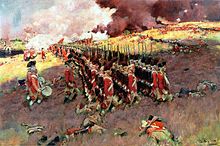Howard Pyle
Howard Pyle | |
|---|---|
 | |
| Nationality | American |

Howard Pyle (March 5, 1853 – November 9, 1911) was an American illustrator and writer, primarily of books for young audiences. A native of Wilmington, Delaware, he spent the last year of his life in Florence, Italy.
In 1894 he began teaching illustration at the Drexel Institute of Art, Science and Industry (now Drexel University), and after 1900 he founded his own school of art and illustration called the Howard Pyle School of Illustration Art. The term the Brandywine School was later applied to the illustration artists and Wyeth family artists of the Brandywine region by Pitz (later called the Brandywine School).[1] Some of his more famous students were Olive Rush, N. C. Wyeth, Frank Schoonover, Elenore Abbott, Ellen Bernard Thompson Pyle, Allen Tupper True, Anna Whelan Betts, Ethel Franklin Betts, Harvey Dunn and Jessie Willcox Smith.
His 1883 classic The Merry Adventures of Robin Hood remains in print to this day, and his other books, frequently with medieval European settings, include a four-volume set on King Arthur that cemented his reputation.
He wrote an original novel, Otto of the Silver Hand, in 1888. He also illustrated historical and adventure stories for periodicals such as Harper's Weekly and St. Nicholas Magazine. His novel Men of Iron was made into a movie in 1954, The Black Shield of Falworth.
Pyle travelled to Florence, Italy to study mural painting in 1910, and died there in 1911 of sudden kidney infection (Bright's Disease).
Major works
In addition to numerous illustrations for Harper's Weekly, other periodical publications, and the children's books of others, Pyle wrote and illustrated a number of books himself.
The Merry Adventures of Robin Hood is Pyle's distillation of many Robin Hood legends and ballads, modified to make them suitable for the child audience he sought to appeal to. He modified the ballad "Robin Hood's Progress to Nottingham", changing it from Robin killing fourteen foresters for not paying on a bet, to the robbers threatening Robin, and Pyle has Robin kill only one man who shoots at him first. Tales where Robin steals all that a traveler carried, such as "Robin Hood and the Bishop of Hereford", were changed so that the victim keeps a third, and another third is dedicated to the poor.


Pyle did not have much more concern for historical accuracy than the ballads, though he did alter the name of the queen in "Robin Hood and Queen Katherine" to Queen Eleanor, historically compatible with the king with whom Robin made his peace being King Richard the Lion-Hearted.
Indeed, none of the tales in the book were Pyle's own invention. However, he wove the tales together to form a unified story. The adventure with the Curtal Friar, for instance, was not an isolated tale, but undertaken to bring back Friar Tuck, because a priest was needed to marry Allan a Dale to his sweetheart Ellen. Again, in "A Gest of Robyn Hode", the knight saved an anonymous wrestler who had won a bout but was likely to be murdered because he was a stranger, and Robin says that this excuses his delay, and that anyone who helps good yeomen is helpful to him; Pyle adapted it so that the wrestler was David of Doncaster, one of Robin's band in "Robin Hood and the Golden Arrow". Several characters that had appeared in only one ballad, such as David of Doncaster and Arthur a Bland, are more fully developed in this novelistic treatment of the tales.

Pyle also wrote Otto of the Silver Hand, a story about the life of the son of a robber baron in the Dark Ages. In 1887 he wrote The Wonder Clock, a collection of twenty-four tales, one for each hour of the day. Each tale was prefaced by a whimsical verse telling of traditional household goings-on at that hour, illustrated by his sister Katharine. The tales themselves were written by Pyle based on traditional European folktales. A similar volume was Pepper and Salt, or Seasoning for Young Folk, which consisted of tales of traditional types for younger readers, also charmingly illustrated.
A number of pirate legends by Pyle, including some of his drawings, were collected as Howard Pyle's Book of Pirates, published in 1921, ten years after his death.
In 1903, Pyle published Rejected of Men: A Story of To-day, a re-imagining of the story of Jesus as if it had taken place in early twentieth-century America.
Critical response
Pyle was widely respected during his life and continues to be highly regarded by illustrators and fine artists. His contemporary Vincent van Gogh spoke of Pyle in a letter to his brother, saying that Pyle's work "...struck me dumb with admiration".[2]
See also
References
- ^ McDonald, Edward D. (1942). Drexel Institute of Technology 1891 - 1941. Haddon Craftsmen, Inc. pp. 126–130. ISBN 1406763748.
{{cite book}}: Unknown parameter|coauthors=ignored (|author=suggested) (help) - ^ Howard Pyle Online
